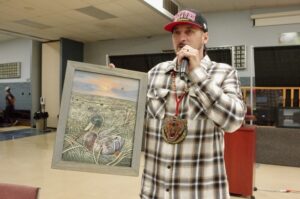Fort William celebrates first Annual Fall Festival

By Rick Garrick
FORT WILLIAM — Cree artist/rapper Shibastik shared details about his art, including a duck decoy painting, during his performance at Fort William’s first annual Fall Festival on Oct. 23 at the Fort William First Nation Community Centre.
“Our tradition where I go hunting in the fall is miles and miles of flats [on James Bay] that are under six-feet of water twice a day with the low tide, high tide,” says Shibastik, a Moose Cree citizen. “We can’t carry all our decoys so as soon as the tide goes out we walk out there, it takes like half-an-hour. We quickly make a blind and we use mud decoys; we just flip up the mud, it’s clay with this black mud underneath, so it’s these little black mounds with a white stick, a piece of driftwood.”
Shibastik says the snow geese they are hunting have dark bodies and white heads.
“As we are killing our ducks and geese with the mud decoys, instead of piling up our ducks, we make decoys out of them,” Shibastik says. “So that [painting] is one of the ducks we shot — it’s done from a photograph that I took.”
Shibastik also performed some of his songs, including his song Flow ft. Bradley A.J. and Deanne Rose Moore from his Land Bass album that is up for the Native American Music Awards on Nov. 19 at the Seneca Niagara Hotel and Casino in Niagara Falls, NY.
“I had a great time,” Shibastik says. “To be a part of an event like this that is about the culture, sharing the culture, and fighting to bring our culture back, to be a part of anything like this is always a huge honour.”
The Fall Harvest also featured traditional crafts and teachings and live demonstrations as well as bouncy castles and activities for children.
“It’s beautiful, it’s hands-on, there’s lots of things for people to learn,” says Danielle Pelletier, Ontario Works case worker at Fort William. “Inside it’s face painting for the kids and [bouncy castles]. Outside is actual activities that go back to when we lived off the land, so there’s tan hiding out there. Everybody has a booth for us to learn, Science North, we have a teepee for sharing circles, and we’re going to have a supper at 5 p.m.”
George Price, a Coast Salish wood carver from B.C. who lives in Thunder Bay, says he had a kit for building canoes for the children.
“Its got the side ribs and it also comes with the sinew — from there you learn how to stitch,” Price says. “I brought some awls and birch bark so they can learn how to poke holes into the bark, and also I’ve got a block of wood here so sometime today I’m going to split it and make some sheathing for the flooring.”
John Walmark, a Lac La Croix citizen and Indigenous heritage specialist at Fort William Historical Park, says they were demonstrating gill-net making, which is part of a program they developed for Matawa First Nations Management in Thunder Bay.
“We’re going to be delivering a train-the-trainer program for them at the Fort,” Walmark says. “We’re going train the trainers who are going to be training youth in their communities.”
Mishkeegogamang Elder Maxine Baer and Isabel Beardy and Brenda Beardy, both Muskrat Dam citizens, also cooked up some bannock, fried bread, and moose stew over a campfire for the feast.
“It’s good, it tastes like smoked bannock when it’s cooked like that,” Baer says about the bannock that she cooked in a frypan.

